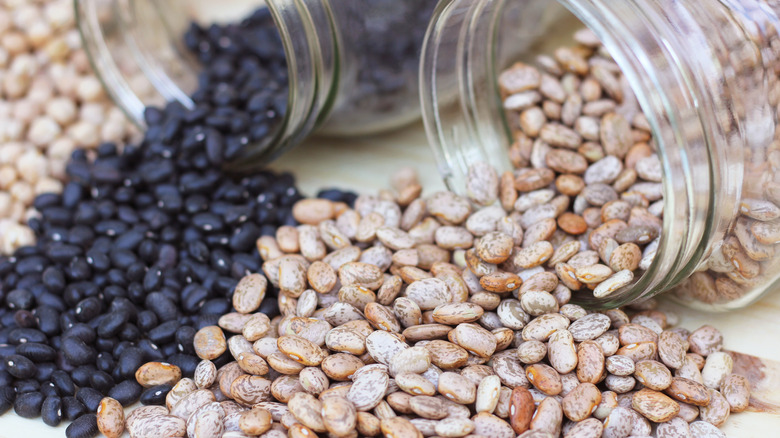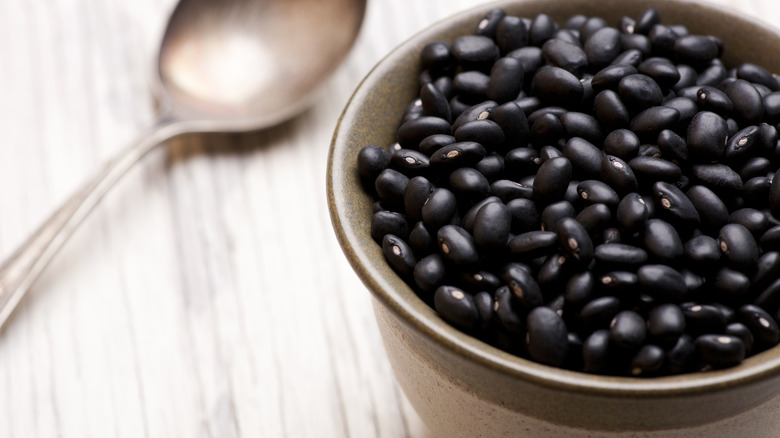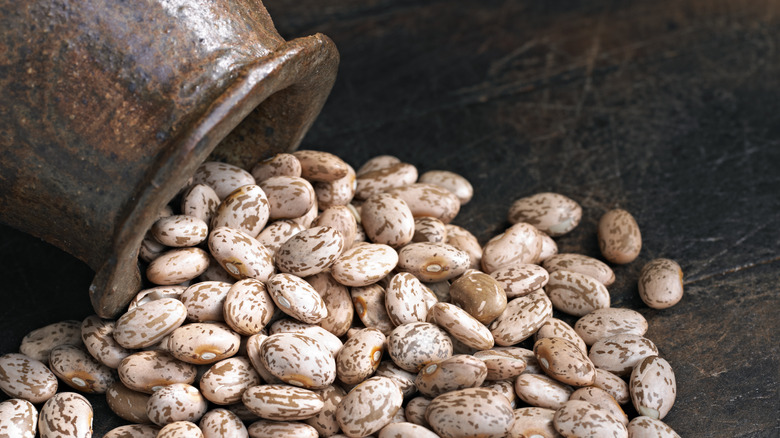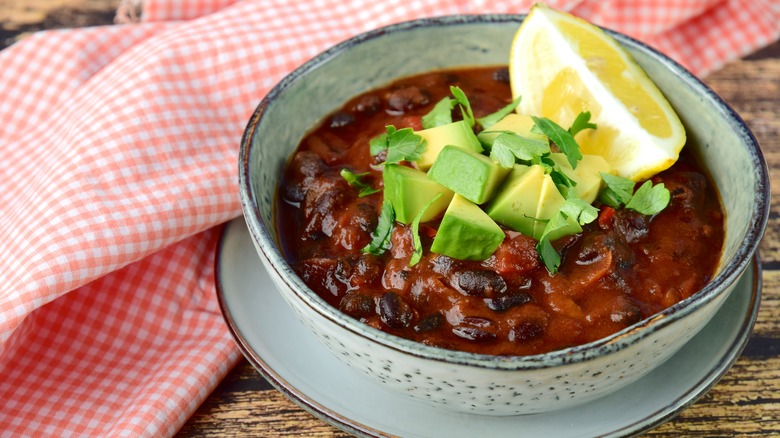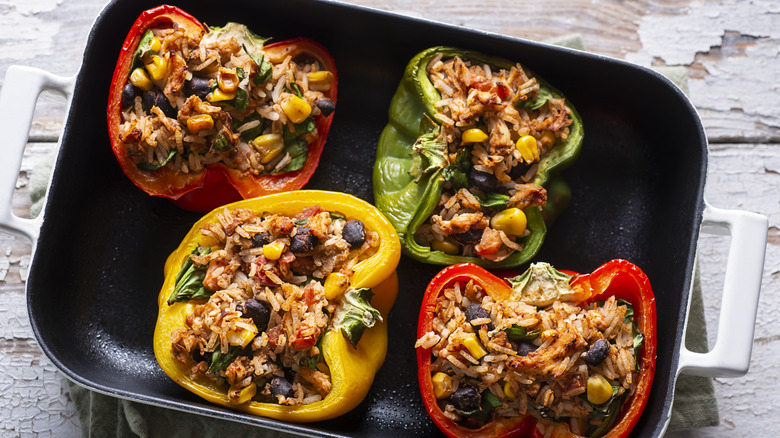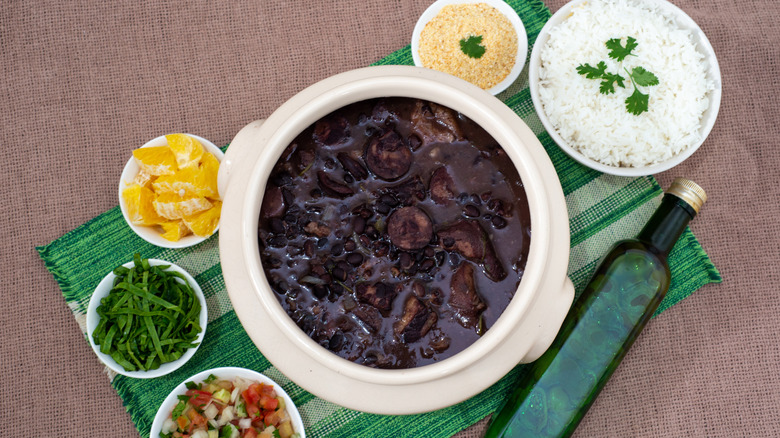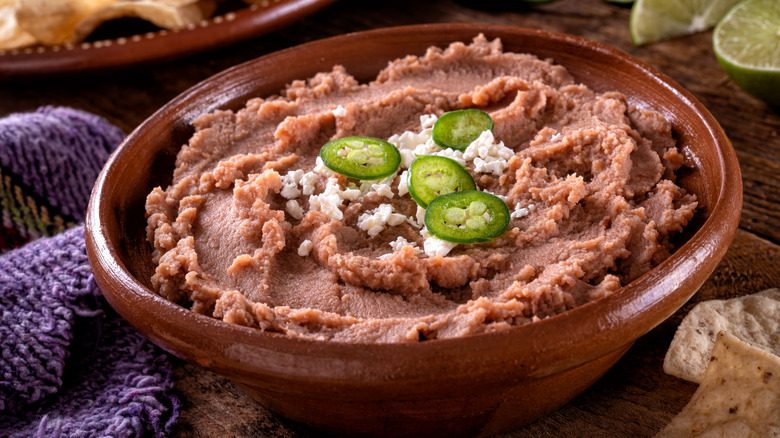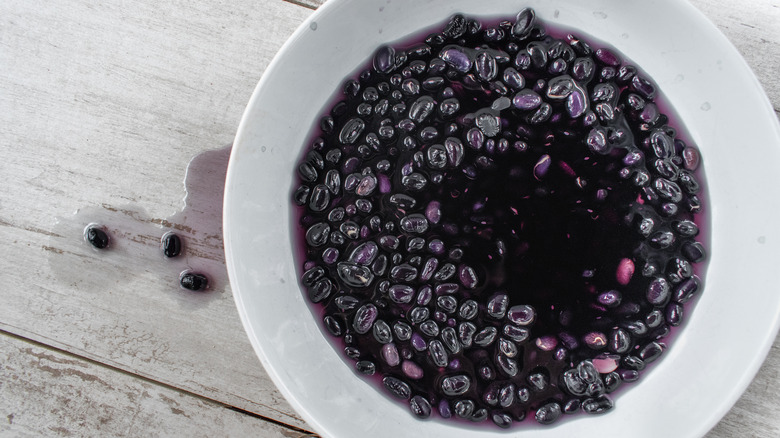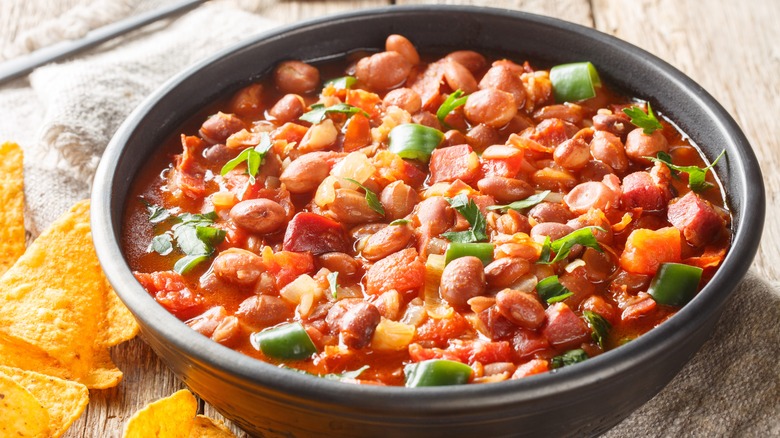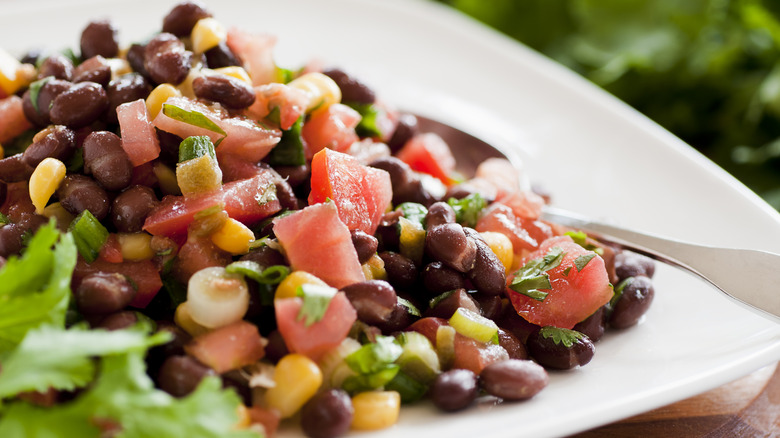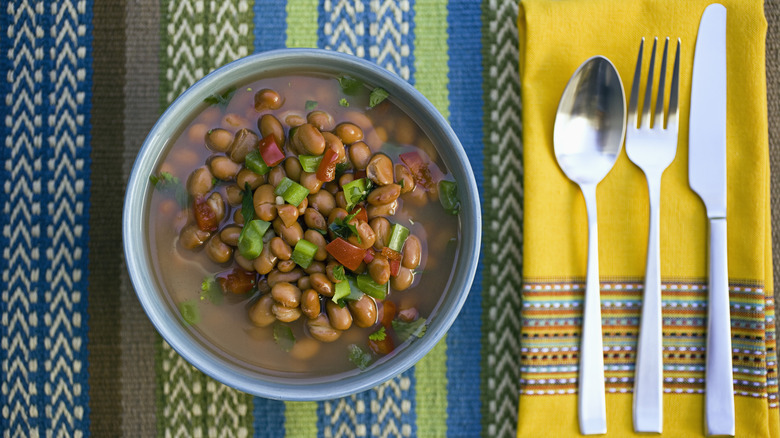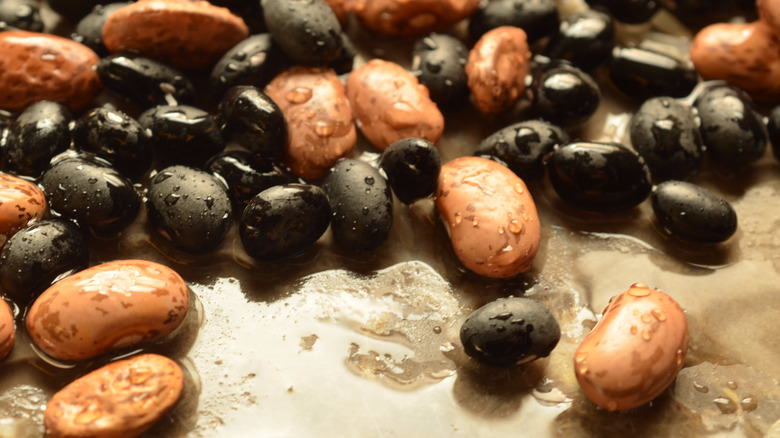Black Beans Vs Pinto Beans: Everything You Need To Know
Whether you are attempting to replicate a country's national dish or just trying to find the best bean for the culinary purpose you have in mind, it is essential to consider a bean's many characteristics. Black beans and pinto beans are featured in a variety of dishes, sometimes interchangeably, but using them as the same legume is a big culinary misstep.
When it comes to the differences between black beans and pinto beans, the main thing is to start at the end: Consider the final dish. Black beans are best for dishes where the entirety of the bean — its shape and color, in addition to flavor and texture — is prominent and prized. They retain their shape and beautiful, rich hue during proper cooking and are best selected when you want to see the bean. The national dishes that celebrate the black bean would be nothing without this legume's particular characteristics. But are you looking for the perfect base note, the underlying creamy texture, or neutral nutty, earthiness that makes other ingredients shine? In that case, pinto beans are the best choice. Of all types of beans, pintos are the ones that create a smooth foundation upon which to layer flavor (we're looking at you, seven-layer dip).
In most cases, black beans and pinto beans are the least interchangeable pair of beans. From their history to their cooking to the countries they call home, here's everything you need to know about black beans and pinto beans.
What are black beans?
Black beans, also known as turtle beans, are a small legume that is the edible seed of the plant. They are native to South and Central America, dating back 7,000 years, and belong to the Fabaceae family, a genealogy that includes black locust and redbud trees. Recognize these frijoles negros also by their oval shape, shiny black coating, and small white spot on the belly of the bean (the keel). Each bean measures between 1/4 and 1/2 inch. The inside of the bean is flavorful and meaty when cooked.
Black beans are the fastest-growing legume on the market in terms of consumption. They were virtually unknown in the United States except for small neighborhoods of South American immigrants until the 1970s when a good PR team and the bean's natural versatility shoved them into the spotlight. From 1970 to 2017, consumption of black beans rose by 1 pound per person annually in the U.S. Across the globe, black beans are a staple in the diets of many people who consume little to no animal protein; they are foundational to Cuban, Haitian, and Mexican cuisines but make plenty of appearances in Brazil and countries that circle the Mediterranean. Canned or dried or in prepackaged meals, black beans are popular in various dishes that suit different palates.
What are pinto beans?
Pinto beans are named for their appearance: Pinto means painted in Spanish and the abstract expressionist splashes of reddish brown that color the exterior of this small tan legume create miniature works of art. Cultivated by early Mexican and Peruvian cultures around 5,000 years ago, this common bean is a favorite in the western United States, where Tex-Mex cuisine makes ample use of it. Pintos are in the same family of beans as black beans, and they are similar in size and have a keel where the bean connects to the plant. Their speckles make them easy to recognize (although they are no longer pronounced when the beans are cooked).
Across the U.S., pinto beans are no slouch when it comes to increasing popularity. In 2017, pinto beans clambered up the bean-counting charts, with people in the U.S. consuming an average of 2.9 pounds annually. They are the most popular bean in the U.S., with a neutral flavor and texture ideal in soups, stews, and dips.
Black beans are sweeter than pinto beans
You might not expect a savory bean to taste sweet, but black beans rule the day when it comes to this unexpected flavor. The flavor is mild, but black beans have a slightly sweet, meaty taste, making them a perfect choice for vegetarian chili. The meaty undertone of the bean provides a hint of the missing animal protein, and the subtle sweetness balances out the acid tang of tomatoes and lime and the zing of chilis and hot sauce.
Pinto beans have a less pronounced flavor, even more subtle than black beans. Choose pinto beans when you are looking for a nutty, earthy taste that provides a subtle backdrop for more robust flavors. Refried beans that accompany strong meats or other flavors pair well with the pinto's mild flavor. This is not to say that pintos lack flavor; instead, pinto beans really shine as a buoyant accompaniment that helps lift all other tastes without fighting for dominance.
They vary in texture
People often overlook the importance of texture when planning a menu, but it can make or break a meal. Black beans and pinto beans vary tremendously in their textures, which means they also work well in vastly different dishes.
Black beans maintain their firm texture, even after a long period of cooking. Their shape is distinct, and their skin remains taut. Because of this, black beans are best when you want a distinct bean shape and texture — think cold black bean salad and chili, where the bean's texture mimics ground beef.
Pinto beans are the go-to if you want a silky, creamy texture. Their thin skin melts in the pan when cooked, and the interior of the beans becomes soft, making them perfect for mashing and thickening soups and stews where texture is key. Refried beans are traditionally made with pinto beans; the mushy texture results in a smoothly blended finished dish.
Black beans are common across culinary cultures
Black beans may have originated in the Americas, but they have traveled across the globe and are featured in various culturally significant dishes. Of course, cuisines in South and Central America have put their own spin on black beans and rice, but it goes much deeper than that. In the Yucatan, a black bean and pork soup called bul keken is served; in Cuba, it's sopa de frijoles negros cubana, and in Brazil, feijoada is the traditional stew. Feijoada is the national dish of Brazil, and it is enjoyed by people in a country that is the largest consumer of black beans globally.
In the United States, many people enjoy black bean burgers opposed to animal protein but other simple recipes using this flavorful legume abound. Pockets of different cultures bring their traditional black bean dishes with them and adapt to the changing American palate, but there are many other ways that people in the U.S. consume black beans. From vegetarian black bean taquitos to quick and tasty black bean salads at potlucks, black beans are a prominent part of the American table.
Pinto beans are perfect for many Mexican dishes
Pinto beans' specific texture and neutral flavor are purpose-built for Mexican and Southwestern cuisine. Refried beans are the obvious creamy dish, but you can also find them in layered dips and creamy soups or stews. The traditional Mexican molletes, an open-faced sandwich packed with melted cheese and refried beans and topped with pico de gallo, is another way to enjoy them. Add a fried egg for the perfect morning-after-the-night-before breakfast. The most straightforward preparation is frijoles de olla: stewed pinto beans and onions in a flavorful sauce.
But spicy Latin flair isn't the only flavor profile that fits the pinto. Chilly New Englanders sometimes choose the pinto for its perfect creamy texture in a flavorful pot of spicy, sweet oven-baked beans (with or without weenies but nearly always with a hit of yellow mustard). It's not the traditional bean of choice (navy beans fill that spot), but the texture is perfect if you need an easy swap.
Black beans retain more water
Black beans absorb more water and expand more during cooking than pinto beans. This can result in a slightly larger volume of cooked beans, but many factors influence this. Although black beans are slightly smaller than pinto beans, since their starch molecules absorb more water and expand, they can become as large as cooked pinto beans.
What does this have to do with cooking and enjoying either black or pinto beans? When dry black beans are soaked overnight before cooking, you must plan for a larger volume of water to accommodate their absorption. You'll also need to pay attention to the liquid levels during cooking. Depending on the cooking method, dry beans can take several hours to soften, and they should always be submerged in liquid. Adding cold water to the cook pot will also add time to the process. Of course, using canned beans cuts cooking time substantially and makes for easier bean recipes that can still be largely hands-off.
For both black and pinto beans, the amount of water needed for soaking or cooking doesn't affect the amount of beans too substantially. Be aware that the dry form will expand during the cooking process. One cup of dried beans yields approximately 3 cups of cooked beans.
Pinto beans have the iron edge
Legumes of all kinds are a healthy part of a balanced diet. Per 1/2 cup, both cooked black beans and pinto beans provide high amounts of protein, with black beans just slightly higher at 8 grams (to pinto beans' respectable 7 grams). They also have similar amounts of healthy carbs, potassium, and fiber to keep you full.
Black beans have 23 milligrams of calcium per cooked 1/2 cup and are also a good source of folate and vitamin K. In addition to their vitamin and mineral profile, black beans have been studied extensively for their effects on various health conditions. They have been shown to lower blood pressure, manage diabetes, prevent heart disease, and keep cancer at bay. Some researchers credit the presence of quercetin and saponins, and others point out that vitamins like folate and selenium, plus copious antioxidants in their richly hued skins, help keep eaters healthy. Don't count pinto beans out, though. They have a slight edge over black beans in terms of iron — 1 cup of pinto beans has 20% of your daily recommended value of iron. They are also packed with kaempferol, a specific compound associated with lower stroke rates and reduced inflammation in the body.
If you are watching your sodium, prepare black and pinto beans from dry. If you use canned beans, don't make the mistake of thinking they are all the same. Choose low-sodium versions of your canned favorites. Read the label and avoid added fat, flavoring, or artificial ingredients.
Black beans have a lower glycemic index
The glycemic index (GI) is a dietary phrase thrown around, sometimes with little understanding, but it's a very simple concept. The glycemic index measures how quickly a food causes blood sugar to rise; the faster blood sugar increases, the faster (and harder) it falls. The scale is rated zero to 100, and the higher the GI, the more rapidly food is digested, with a spike (and corresponding trough) in blood sugar. A regular chocolate bar, for example, has a GI of 70, and most ultra-processed foods are similar.
Black beans have a GI of 30 and are high in fiber and antioxidants, both of which help you feel more satisfied after eating. For people with diabetes or who are working on developing and maintaining a healthy weight, black beans can help you feel fuller, longer, and keep your blood sugar even.
On the other hand, pinto beans are at the top end of the bean section of the GI. Their number is 39, which is still respectable when compared to a chocolate bar but still high for whole food. But some people happily swap the slightly higher number for the creamy texture of pinto beans slathered on a mid-day quesadilla or nestled in a taco. Ultimately, both options are solid choices when working on dietary improvements.
Pinto beans may be easier to digest
Beans are notorious for certain flatulent side effects that can be embarrassing and uncomfortable. Beans fall into the category of foods with FODMAPs (an acronym that stands for fermentable oligosaccharides, disaccharides, monosaccharides, and polyols). The bacteria in our gut love these and munch away, producing gas that then must exit the body somehow. To prevent excessive flatulence, the best solution is to use canned beans and rinse them thoroughly before using, but the next best defense is to choose pinto beans.
Pinto beans seem to be somewhat easier to digest. The same skin that breaks down and creates that smooth bean puree is also easier to break down in the gut. Their texture, when eaten, is usually softer than that of black beans, and they don't retain any of their shape, making them almost predigested (in a way).
Of course, you can certainly soak dry beans overnight and drain the cooking water, rinsing the beans. Some people swear this is the best way to combat gassiness. Others believe a teaspoon of baking soda is the answer, or eating more beans so that your body gets used to them and produces less gas. Ultimately, whatever works for you is the best method to try.
Black beans may not require soaking
Conventional wisdom states that black beans should be soaked for at least six hours and up to overnight before cooking. The soaking water should be changed, and then the beans can be cooked. However, for the most flavorful black beans, soaking dried beans overnight may not be necessary. This overnight soaking and multiple changes of water may actually affect both the structure and the flavor, and it doesn't necessarily speed up the cooking process too much. Soaking dry black beans overnight does reduce the chances of split or blown-out beans, which matters if you're creating a dish that relies on the shape of the whole bean.
Pinto beans are also quite forgiving when it comes to soak time, but soaking does shorten their cooking time. When it comes to dishes with two cooking processes (refried beans, for example, or stews that use cooked beans), a decrease in cooking time might be beneficial to the cook. Pinto beans are also often mashed or pureed and need to be absolutely soft before those things can happen.

